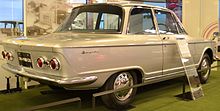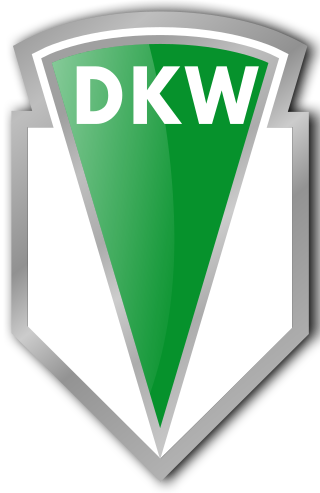
DKW was a German car- and motorcycle-marque. DKW was one of the four companies that formed Auto Union in 1932 and thus became an ancestor of the modern-day Audi company.
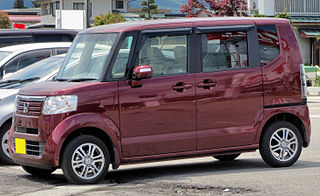
Kei car, is the Japanese vehicle category for the smallest highway-legal passenger cars, with restricted dimensions and engine capacity. Similar Japanese categories exist for microvans, and kei trucks. These vehicles are most often the Japanese equivalent of the EU A-segment.

Suzuki Motor Corporation is a Japanese multinational corporation headquartered in Minami-ku, Hamamatsu, Japan. Suzuki manufactures automobiles, motorcycles, all-terrain vehicles (ATVs), outboard marine engines, wheelchairs and a variety of other small internal combustion engines. In 2016, Suzuki was the eleventh biggest automaker by production worldwide. Suzuki has over 45,000 employees and has 35 production facilities in 23 countries, and 133 distributors in 192 countries. The worldwide sales volume of automobiles is the world's tenth largest, while domestic sales volume is the third largest in the country.

The Mazda Carol is a kei car manufactured by Mazda from 1962 until 1970. The Carol name was revived again with Mazda's 1989 re-entry into the kei car class with the Autozam brand. Since 1989, the Carol has been a rebadged model manufactured by Suzuki for Mazda, based on the Japanese Suzuki Alto. The first two generations of the modern era Carols received unique bodywork, but since late 1998 the nameplate has been strictly a badging exercise.

The Subaru Rex, also known as Ace, Viki, Sherpa, 500/600/700, Mini Jumbo, Mini Subaru or M60/M70/M80 in various export markets, is a kei class automobile produced from 1972 to 1992 mainly for sale in Japan by Subaru, although it was also sold in Europe, South America, Australia and the Caribbean. The Rex superseded the R-2 as Subaru's kei car, and has been available in commercial use versions as well as in a passenger car version. It underwent major changes in 1976, in fall 1981, and again in late 1986. The second generation Rex (1981–1986) also formed the basis for the larger Subaru Justy.
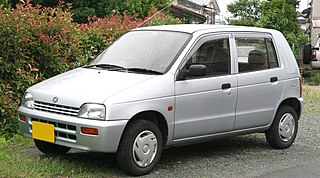
The Suzuki Alto is a kei car produced by Suzuki since 1979. The model, currently in its ninth generation, was first introduced in 1979 and has been built in many countries worldwide. The Alto originated as a commercial vehicle derivative of the Fronte, but over time the Alto nameplate gained in popularity and by 1988 it replaced the Fronte name completely. The Alto badge has often been used on different cars in Japan and in export markets, where it is considered a city car.

The Daihatsu Fellow Max is a small Japanese automobile in the Kei car class. Originally introduced as the Daihatsu Fellow, the name was partially retained for its successor, the Max Cuore (1977), and then revived in 2000 for the Daihatsu Max.

The Mitsubishi Minica is a kei car produced by Mitsubishi Motors mainly for the Japanese domestic market from 1962 to 2011. It was first built by Shin Mitsubishi Heavy-Industries, one of Mitsubishi Heavy Industries' three regional automotive companies until they were merged in 1964, and as such predates MMC itself. In Japan, it was sold at a specific retail chain called Galant Shop. In 2007 and 2011, the car was replaced with the Mitsubishi eK and the Mitsubishi i.
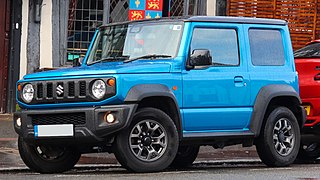
The Suzuki Jimny is a series of four-wheel drive off-road mini SUVs, manufactured and marketed by Japanese automaker Suzuki since 1970.

The Suzuki Fronte is an automobile that was first introduced in March 1962 as a sedan version of the Suzulight Van. The nameplate remained in use for Suzuki's Kei car sedans as well as some commercial-use derivatives until it was replaced by the Alto name in September 1988. The word "fronte" alludes to the fact that the car is front-wheel-drive, although during the years when the Fronte was rear-engined, rear-wheel-drive, Suzuki stated that it referred to the car being at the front of the Kei class.

The Daihatsu Hijet is a cab over microvan and kei truck produced and sold by the Japanese automaker Daihatsu since 1960. Despite the similarities between the Hijet name and Toyota's naming scheme for its trucks and vans, the name "Hijet" has been in use for Daihatsu's kei trucks and microvans since 1960, over two decades before Toyota took control. "Hijet", when transliterated into Japanese, is very similar to "Midget", one of Daihatsu's other mini-trucks. According to Daihatsu, the name "Hijet" was created to imply that the vehicle offers higher performance than the Midget. The Hijet competes in Japan with the Honda Acty, Mitsubishi Minicab, Nissan Clipper, Subaru Sambar and Suzuki Carry.

The Suzuki Mighty Boy is an automobile which was produced by Japanese automaker Suzuki from 1983 to 1988. It was the only "bonnet type" pick up ever sold in the 550 cc era of the Kei class. It was classified as a commercial vehicle in Japan so as to benefit from lower taxes for such vehicles, but its utilitarian values were certainly restricted. While the Mighty Boy was not a runaway success and was never replaced in the Suzuki lineup, the car still has a dedicated following in Japan.
The Suzuki Cervo is a kei car manufactured by Suzuki Motor Corporation. Introduced in 1976 as the successor to the Suzuki Fronte Coupé, the Cervo name was originally affixed to a kei sports coupe, and then to models derived from the Suzuki Alto. The nameplate was retired between 1998 and 2006, and again in December 2009.

The Mitsubishi Colt 800 is the first of a series of passenger cars with a fastback/hatchback design produced by Mitsubishi Motors from November 1965. It was introduced as a two-door fastback sedan, the first such design in the Japanese market. The series was discontinued in 1971, after the introduction of the company's Galant sedan but without a real replacement.

The DKW Junior is a small front wheel drive saloon manufactured by Auto Union AG. The car received a positive reaction when first exhibited, initially badged as the DKW 600, at the Frankfurt Motor Show in March 1957. The ‘Junior’ name was given to the DKW 750 in 1959 when the car went into volume production, but failed to survive an upgrade in January 1963, after which the car was known as the DKW F12. In addition to the saloon, a pretty ‘F12 Roadster’ was produced in limited numbers.

Suzulight was the brand used for kei cars built by the Suzuki Motor Corporation from 1955 to 1969. They were Suzuki's first entry into automotive manufacturing, having previously only produced motorcycles. The Suzulight sedans and light vans all had transversely mounted engines and front-wheel drive. The Suzulight Carry trucks and vans were the first to use the Carry label, still around today.

LC10 was the original name given to a series of very small three-cylinder, two-stroke engines built by Suzuki Motor Corporation in the 1960s and 1970s. They were used in a number of kei class automobiles and light trucks. The LC10 and its derivatives did not completely replace the FE and L50 two-cylinders, which continued to be used mainly for light commercials. The LC10 engine was developed together with the Suzuki B100 engine, a 8–11 PS (5.9–8.1 kW) 118.9 cc (7.26 cu in) single-cylinder motorcycle engine which shared the same bore and stroke. For longevity and convenience, the LC10 received Suzuki's new "Posi-Force" auto-lubrication system, eliminating the need for pre-mixed fuel.
The Daihatsu A-series engine is a range of compact two-cylinder internal combustion piston engines, designed by Daihatsu with the aid of their owner Toyota. Petrol-driven, it has cast iron engine blocks and aluminum cylinder heads, which are of a single overhead cam lean burn design with belt-driven camshafts. The head design was called "TGP lean-burn", for "Turbulence Generating Pot". The engine also had twin balancing shafts, which provided smoothness equivalent to that of a traditional four-cylinder engine - although it also cost nearly as much to build.

The Suzuki FB engine is a series of two- and three-cylinder two-stroke engines that was produced by the Suzuki Motor Corporation from October 1961 until November 1987. They were used in a number of Kei-class automobiles and light trucks. From the original air-cooled 359 cc (21.9 cu in) straight-twin version the FB series developed through a number of different models having different names, ending with the water-cooled, three-cylinder LJ50. The names used for various versions of this engine often refer to the chassis code of the cars in which they were introduced, until Suzuki changed their engine naming system sometime in the first half of the 1970s.

The Honda S660 is a two-seat targa sports car in the kei class manufactured by the Japanese manufacturer Honda with a transverse mid-engine and rear-wheel-drive layout. It is the successor to the Honda Beat, and the Honda S2000.

